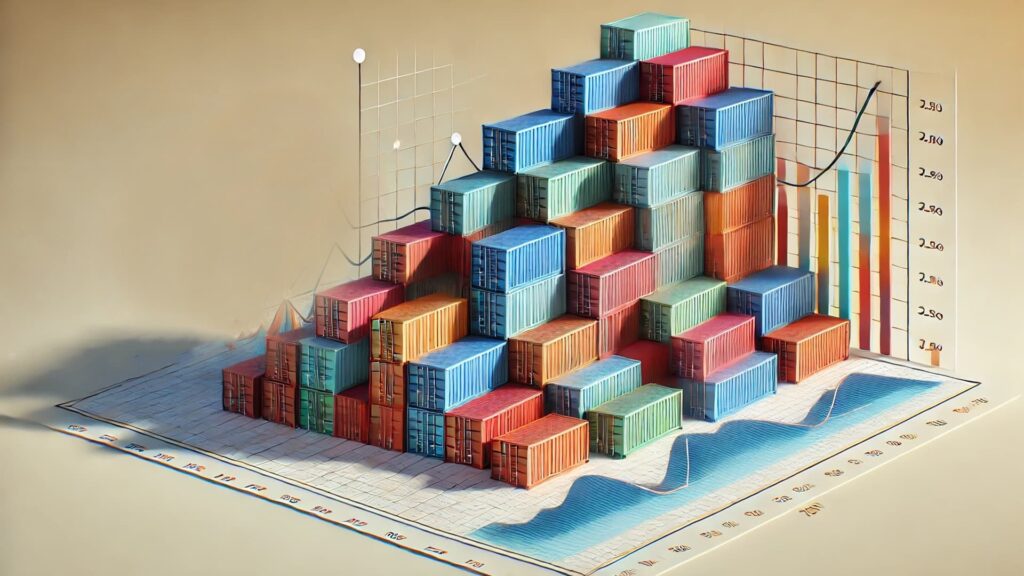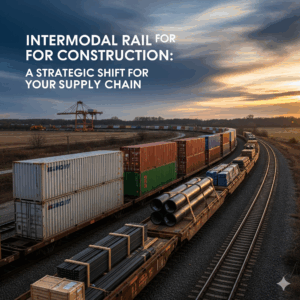This post was last updated on July, 12th 2024
As the global logistics industry continues to evolve in 2025, intermodal containers have proven to be one of the most essential tools for facilitating efficient, cost-effective, and secure freight movement. The demand for intermodal container shipping is surging due to increased global trade, e-commerce growth, and an ongoing need for flexible supply chain solutions. In this comprehensive guide, we explore the latest intermodal container statistics in 2025 and reveal powerful insights to help shippers, carriers, and logistics professionals navigate the changing transportation landscape with confidence.
Intermodal containers, also known as shipping containers, are standardized steel units that allow goods to be transported seamlessly across multiple transportation modes – truck, rail, and ship – without the need to unload or reload cargo. This intermodal advantage offers significant cost savings, faster transit times, and improved cargo security. In 2025, the global fleet of intermodal containers has reached over 50 million TEUs (twenty-foot equivalent units), marking a 7% increase from the previous year. North America alone accounts for over 25% of this growth, with Canada and the U.S. investing heavily in intermodal infrastructure to meet rising freight demands.
The intermodal container market is being driven by technological innovation, environmental regulations, and shifting trade patterns. Smart containers equipped with IoT sensors are now standard across many supply chains, providing real-time visibility into container location, temperature, humidity, and even door activity. This evolution in intermodal container technology empowers companies to reduce loss, optimize inventory, and make data-driven logistics decisions.
The trend toward decarbonizing transportation is also influencing the growth of intermodal container use. Rail shipping, a key component of intermodal transport, emits significantly fewer greenhouse gases than long-haul trucking. As a result, businesses are turning to intermodal containers as a more sustainable option for cross-border and domestic freight. In 2025, over 30% of Canadian rail freight is containerized intermodally – an increase driven by environmental compliance and fuel savings.
Another compelling statistic: intermodal container dwell times at major terminals in Canada have decreased by 12% due to terminal automation and AI-based scheduling. This reduction translates into faster delivery cycles and less demurrage for shippers. Carriers and terminal operators are adopting advanced software to prioritize and streamline container movements, improving the efficiency of intermodal container logistics.
What about cargo types? The versatility of intermodal containers makes them ideal for a wide range of freight: from bulk agricultural goods to finished electronics, furniture, consumer packaged goods, and refrigerated perishables. In fact, reefer containers now represent 9% of the total intermodal container fleet worldwide – and this figure is expected to grow as cold chain logistics become a priority for food and pharma industries.
Canada’s domestic intermodal container movements have seen a 15% year-over-year increase, with strong volumes moving between Toronto, Montreal, Calgary, and Vancouver. These hubs act as strategic intermodal exchange points where containers shift between rail and truck for final delivery. Companies are leveraging this network to gain efficiency and reduce road congestion in urban corridors.
Digital transformation is a key enabler in modern intermodal container operations. In 2025, over 80% of intermodal shipping transactions in North America are now managed through digital freight platforms, offering paperless booking, electronic bill of lading (eBOL), and integrated shipment tracking. The digitization of intermodal logistics not only reduces administrative overhead but also improves transparency and responsiveness.
Despite global uncertainties, intermodal container volumes remain strong. The Port of Vancouver reported an 8% increase in intermodal container throughput in Q1 2025 alone, with similar trends observed in Halifax, Prince Rupert, and Montreal. These figures reflect a resilient supply chain bolstered by strategic partnerships, government investments, and improved infrastructure.
The labor market is also adapting to the growing importance of intermodal container logistics. More training programs are emerging for intermodal terminal operations, crane handling, and container yard management. Companies investing in skilled labor are reporting smoother operations, higher container turnover, and better customer satisfaction rates.
Cost metrics are another vital consideration for shippers. In 2025, the average cost per mile for intermodal container rail transport is approximately 40% lower than over-the-road trucking for long-haul routes. As diesel prices fluctuate and labor shortages affect the trucking sector, intermodal rail with containers offers a more stable and predictable cost model.
Furthermore, intermodal container compatibility across transport modes enhances flexibility. Shippers can quickly switch between rail, ship, and truck depending on market demands, natural disasters, or port congestion. This agility is a cornerstone of supply chain resilience in an increasingly uncertain world.
To make the most of the 2025 intermodal container trends, businesses must stay informed, invest in training, and adopt the latest technologies. Whether you are an enterprise managing a global supply chain or a small business entering cross-border e-commerce, understanding the statistics behind intermodal container usage will help you make smarter, more profitable logistics decisions.
In the following sections of this guide, we’ll explore specific strategies, technologies, and case studies demonstrating how intermodal container logistics is reshaping the shipping industry in 2025. From reducing emissions and improving reliability to increasing shipment visibility and minimizing costs, the benefits of intermodal containers are clearer than ever. Let’s dive deeper into how you can harness these insights to supercharge your freight operations this year.
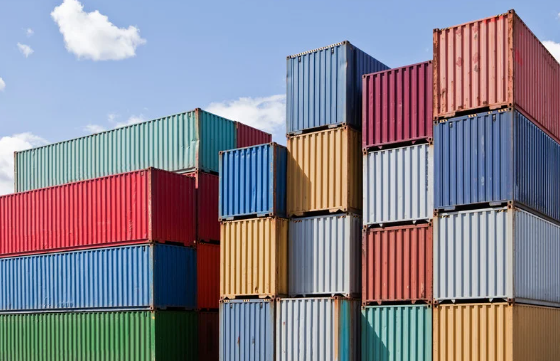
Why Are Intermodal Container Stats Important?
Intermodal container shipping market statistics are essential for tracking global movement of goods, impacting economies and our daily lives. They reveal trends in trade volume, shipping costs, and port capacity, informing businesses about market demand and supply chain efficiency.
By understanding what and where goods are shipped, companies can plan production and distribution effectively. Policymakers also leverage this data to formulate trade policies and invest in infrastructure, ultimately fostering smoother trade, enhanced decision-making, and global economic growth.
Intermodal Container Volume Stats
Approximately 90% of the world’s goods are transported by sea. Some interesting facts are –
- –At any one time, there are approximately 20 million shipping containers adrift at sea.
- The amount of goods carried by containers has risen from 102 million metric tons in 1980 to about 1.83 billion metric tons in 2017.
- It is estimated that around 600 million shipping containers are used today.
- Maritime transport/Ocean shipping more than doubled between 1990 and 2020 from four billion tons to eleven billion tons as per Statista.com
The Growth of the Intermodal Container in Recent Years
Many things have influenced this ever-changing industry, from a growing global trade network to new technologies and worries about the environment.
Let’s take a closer look at what’s been happening in the intermodal container ship fleet industry over the past ten years. We’ll focus on how the size of fleets has changed, where ships are traveling, and the challenges the industry faces.
By breaking down these changes in a clear way, we can understand how things have shifted and what the future might hold for intermodal container shipping. Let’s explore some key developments:
- Bigger Ships
Companies are increasingly utilizing massive vessels called Ultra-Large Container Ships (ULCVs). These behemoths can transport vast amounts of cargo, making shipping more efficient and cost-effective. This trend reflects a push for greater savings and efficiency, benefiting both businesses and consumers.
- Industry Alliances
Shipping companies are forming partnerships, allowing them to pool resources like ships and ports. This collaboration improves customer service and ensures more reliable shipping. Imagine one company’s delay being covered by another in the alliance, ensuring smooth operations for everyone.
- Tech Revolution
The industry is embracing technology, implementing digital tracking systems that monitor shipments from start to finish. This enhances transparency and streamlines the supply chain. Additionally, there’s a focus on developing eco-friendly engines to minimize pollution. These advancements demonstrate the industry’s commitment to innovation, sustainability, and adapting to evolving regulations.
- Shifting Trade Routes
Global production and consumption patterns are changing. As a result, new shipping routes have emerged, connecting different parts of the world in novel ways. This allows ships to reach new destinations, opening doors for trade and business opportunities. These adjustments reflect the dynamic nature of global commerce and the need for shipping to adapt to evolving demands.
- Sustainable Focus
Environmental concerns are driving a push towards “green shipping.” The industry is working to reduce its environmental impact by following stricter pollution regulations and exploring cleaner fuels like natural gas and electricity. This focus on sustainability demonstrates the industry’s commitment to protecting the environment while fulfilling global trade needs.
By understanding these developments, we gain valuable insights into the evolving landscape of container shipping and its future direction.
To What Extent Do Intermodal Container Ships Handle Global Freight Movement?
While intermodal container ships dominate discussions of global shipping, their role is surprisingly specific. Here’s why:
By Weight
Measured in tons, intermodal container ships only handle about 16% of global freight. This means that of all the physical goods shipped internationally, like clothing, electronics, and food, only around 1 in 6 travels on these container ships.
By Value
However, the story changes dramatically when we consider the value of those goods. Intermodal container ships are responsible for transporting over 60% of the total worth of internationally traded goods. This means the most valuable items we trade globally, like high-end electronics or designer clothing, rely on container ships for their journeys.
In simpler terms, container ships might not carry the most weight, but they carry the most valuable cargo. This highlights their crucial role in facilitating global trade for high-value goods.
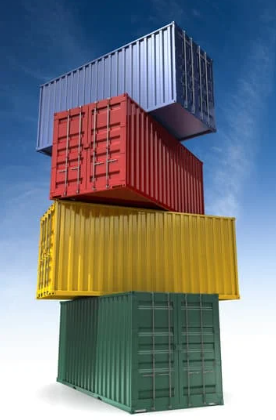
The Future Of Intermodal Container Stats
The shipping industry is on the cusp of a major transformation. Here are of some key trends that businesses and consumers can expect Intermodal containers to take in future:
Embracing Technological Advancements:
- Automation & AI
Ports, terminals, and even ships themselves are increasingly leveraging automation and artificial intelligence (AI). This means using smart technology to optimize shipping routes, predict maintenance needs to prevent breakdowns, and even navigate ships autonomously in certain situations.
- Blockchain Integration
Blockchain technology is streamlining trade finance, container tracking, and supply chain management. It fosters transparency and strengthens record-keeping security, leading to smoother and more trustworthy trade processes for everyone involved.
- Big Data Powerhouse
Utilizing historical and real-time data allows for operational improvements, more effective shipment tracking, and smarter decision-making across the entire supply chain.
Prioritizing Sustainability
- Cleaner Fuel Options
Shipping companies are exploring alternative fuels like natural gas, biofuels, and hydrogen fuel cells to power their vessels. These fuels generate fewer harmful emissions, aligning with stricter worldwide pollution regulations.
- Energy Efficiency Focus
Companies are investing in making ships more energy-efficient by optimizing their hull design, implementing energy-saving technologies, and streamlining operational practices. This approach mirrors efforts to improve car fuel efficiency and improve overall intermodal sustainability.
- Decarbonization Initiatives
Regulatory bodies are implementing stricter emission regulations and exploring carbon pricing mechanisms to incentivize reduced pollution. Collaborative efforts are also underway to achieve net-zero emissions in the shipping industry.
Enhanced Visibility and Transparency:
- Real-Time Tracking
Many companies are employing technology for real-time tracking of intermodal containers, ships, and their cargo. This provides constant visibility into the location and status of goods, facilitating smooth movement and allowing for swift problem-solving.
- Improved Collaboration
Digital platforms and information sharing will foster better collaboration among shippers, carriers, and logistics companies. This will streamline communication and expedite operations, ensuring everyone involved stays informed throughout the process.
- Customer-Centric Approach
Improved transparency translates to a more satisfying customer experience. Businesses and customers can efficiently track shipments, fostering trust and satisfaction throughout the journey.
Adapting to a Changing Landscape:
- Supply Chain Diversification
Companies are exploring alternative sourcing and distribution channels to mitigate disruptions caused by geopolitical conflicts or trade tensions. This can be akin to having a backup plan to ensure business continuity.
- Digital Agility
Increased reliance on digital technologies allows companies to adapt swiftly to market fluctuations and unforeseen events. This enhances flexibility and prepares them for anything the dynamic business environment throws their way.
- Infrastructure Investment
Upgrading ports and investing in transportation networks are crucial for handling future trade volumes and keeping pace with technological advancements. Such investments ensure smooth operations and adaptation to the evolving shipping landscape.
Evolving Trade Landscape
- Regionalization
The growing prominence of regional trade blocs could reshape shipping routes and logistics networks. This can be compared to how students at school might share snacks instead of bringing their own lunch every day.
- Geopolitical Shifts
Shifts in global politics and trade regulations can impact how goods are shipped. These changes will necessitate adjustments in how supply chains are managed and how goods are transported between countries.
- Emerging Market Growth
The rise of economies in Africa and Southeast Asia presents both opportunities and challenges for the shipping industry. While the industry can capitalize on increased trade with these regions, it will also need to pass through their logistical complexities.
Remember, this is just a glimpse into the exciting future of shipping! While the industry is constantly evolving, understanding these trends empowers businesses and customers to make informed decisions and ship through the changes ahead.
Conclusion
As we conclude this deep dive into the world of intermodal containers, it’s clear that the 2025 landscape is shaped by innovation, strategic growth, and data-backed insights. For businesses across Canada and North America, leveraging intermodal container trends is more than an operational upgrade – it’s a powerful competitive advantage. Understanding the metrics behind intermodal container usage, sizing, movement, and technological evolution helps shippers stay agile and profitable in an increasingly complex supply chain environment.
One of the most compelling takeaways from this year’s intermodal container stats is the continued growth in cross-border trade. With streamlined customs protocols, digitized documentation, and expanded terminal infrastructure, intermodal containers are moving across the U.S.-Canada border with record efficiency. If your business engages in international or cross-border shipping, staying updated on the types, availability, and cost metrics of intermodal containers can directly impact service quality and customer satisfaction.
Another significant factor is container standardization. The widespread adoption of ISO containers and the increasing use of smart containers equipped with GPS, temperature sensors, and AI-based monitoring systems signal a major shift toward visibility and control. In 2025, intermodal containers are not just steel boxes—they’re smart, connected, and critical to a shipper’s digital supply chain strategy.
This evolution in intermodal container technology also reflects in the updated fleet data. With more companies transitioning to sustainable shipping models, container usage statistics show a marked increase in the demand for reusable, recyclable, and eco-friendly container options. From 20-foot to 53-foot high-cube containers, the expansion of container types enables companies to match container profiles to cargo needs, cutting waste, fuel consumption, and total transit time.
For logistics managers, procurement specialists, and supply chain analysts, the data we’ve reviewed here offers actionable insights. For instance, metrics like container dwell times, port congestion rates, and chassis availability can determine whether a certain corridor is optimal for shipping. If container velocity is slowing in a particular rail corridor, knowing this ahead of time helps reroute or rebook before delays impact delivery timelines.
Furthermore, 2025’s intermodal container stats also reveal meaningful cost trends. From container lease rates and spot pricing to insurance claims per mode, this data helps guide smarter budgeting. With transportation budgets tightening across many industries, intermodal container utilization can lower costs while improving service reliability. These financial indicators support stronger negotiations with 3PLs, rail carriers, and port operators.
Another key area where intermodal container stats make an impact is risk management. Container theft, cargo contamination, and damage are risks that can be mitigated through proper container selection and routing strategies. The most successful companies in 2025 are those integrating container analytics with shipment planning, choosing not only the right route but the most secure container type.
For businesses exploring how to integrate automation and AI into logistics, container intelligence is a gateway. Smart intermodal containers can now feed data into TMS (Transportation Management Systems), enabling predictive routing, proactive maintenance alerts, and seamless supply chain coordination. The implications are immense – reduced downtime, improved compliance, and higher customer satisfaction scores.
But intermodal containers are more than just technology. They represent adaptability. As consumer demand shifts, weather patterns change, and global trade policies evolve, containers offer modular, flexible solutions that allow businesses to scale operations without reengineering their supply chains. The 2025 intermodal container data shows clearly that businesses investing in flexible shipping solutions are better equipped to respond to disruptions.
Take for example how seasonal fluctuations in agriculture or retail are handled with smart container pooling systems. Businesses that analyze past intermodal container usage can plan inventory movement well in advance, reducing warehousing costs and avoiding capacity constraints. This demand forecasting, powered by container data, is becoming standard best practice.
Additionally, intermodal containers are playing a pivotal role in sustainability efforts. From reduced emissions via rail utilization to energy-efficient reefer containers, the environmental impact is quantifiable. Sustainability teams now use container stats to track Scope 3 emissions, offset programs, and CSR metrics. In a world where ESG (Environmental, Social, and Governance) reporting is gaining weight, container data provides the proof.
As we look to the rest of 2025 and beyond, staying engaged with intermodal container statistics isn’t optional – it’s essential. The best logistics teams are already leveraging these numbers in dashboards, predictive models, and strategic reviews. By keeping your team informed and trained on how to interpret and act on this data, you ensure that your business remains one step ahead.
To close, remember: intermodal container data is more than just a record of what’s happened – it’s a blueprint for what’s possible. From driving operational efficiency and reducing costs to improving visibility and reducing environmental impact, these statistics fuel smarter decisions. With every shipment that travels via intermodal container, you have an opportunity to refine, optimize, and elevate your logistics strategy.
Use the insights from this guide to strengthen partnerships with carriers, forecast demand more accurately, select container types that match your cargo perfectly, and above all, ensure that your supply chain is built to thrive in 2025. The intermodal container is your gateway to better, faster, and smarter shipping. Don’t just move cargo – move forward with confidence.
The future of container shipping is bright! Contact us today to learn more and join the shipment revolution!
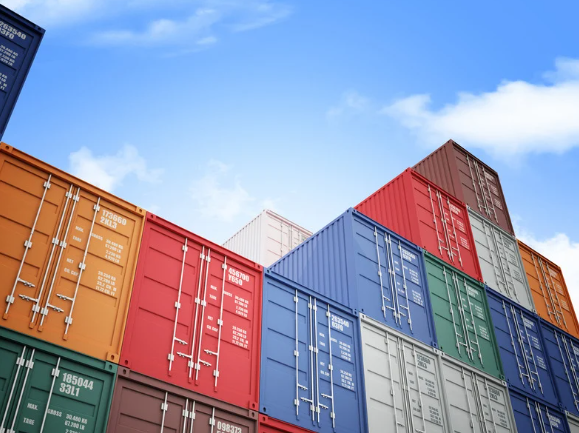
FAQ’s
1. What is an intermodal container?
An intermodal container is a standardized shipping box used to transport goods across multiple modes of transportation, such as truck, rail, and ship. These containers are built for durability and efficiency, minimizing the need to unload and reload cargo. The global use of intermodal containers makes shipping faster, safer, and more cost-effective.
2. What sizes do intermodal containers come in?
The most common intermodal container sizes are 20-foot and 40-foot, also known as TEU (Twenty-foot Equivalent Unit) and FEU (Forty-foot Equivalent Unit). Some providers also offer 45-foot or high-cube containers for oversized cargo. The standardization in sizing ensures compatibility across trucks, ships, and rail systems.
3. How many intermodal containers are in circulation worldwide in 2025?
As of 2025, estimates suggest that over 35 million intermodal containers are actively in use across global supply chains. These containers support trillions of dollars in annual trade. Their rising adoption underscores the global shift toward intermodal efficiency and sustainability.
4. Why are intermodal containers important in global trade?
Intermodal containers allow goods to be moved seamlessly between countries and continents without the need for cargo handling at transfer points. This reduces delays, minimizes damage, and improves supply chain reliability. They’re essential for just-in-time shipping and international commerce.
5. What’s the average lifespan of an intermodal container?
Typically, a well-maintained intermodal container can last 12 to 15 years in active use. After that, containers may be repurposed for storage, modular housing, or construction. Regular inspections and repairs help maximize lifespan and performance.
6. How are intermodal containers tracked during shipment?
Most modern containers are equipped with GPS tracking devices, RFID tags, or IoT sensors. These technologies provide real-time visibility into location, temperature, and handling conditions. This data helps improve shipment security and operational efficiency.
7. What industries rely most on intermodal containers?
Industries such as retail, electronics, automotive, chemicals, and food and beverage heavily rely on intermodal container shipping. These sectors benefit from the ability to move high volumes efficiently across long distances. Even small eCommerce businesses are tapping into intermodal networks to expand globally.
8. Are there different types of intermodal containers for different cargo?
Yes. In addition to dry containers, there are refrigerated (reefer) containers, open-top containers, flat racks, and tank containers. Each is designed to accommodate specific cargo types, whether it’s temperature-sensitive produce or heavy machinery.
9. How has intermodal container usage changed in recent years?
The past few years have seen increased demand due to supply chain digitization, eCommerce growth, and global trade expansion. Ports are processing record container volumes, and rail networks are adapting to meet demand. The shift toward sustainability also makes intermodal a more attractive option.
10. What are the future trends in intermodal container technology?
Future trends include smart containers with advanced tracking, AI-powered logistics optimization, and eco-friendly container construction. These innovations aim to reduce transit times, lower emissions, and improve cargo visibility. The evolution of the intermodal container is central to the future of global freight.
How We Can Help
For businesses looking to optimize their freight shipping with reliable, efficient, and cost-effective solutions, RailGateway.ca is your trusted partner in intermodal logistics. Whether you’re new to freight trains or want to enhance your existing supply chain, our team of intermodal experts is ready to guide you every step of the way.
Contact RailGateway.ca today for a free quote or to speak directly with one of our experienced intermodal specialists. Let us help you unlock smarter, smoother shipping solutions tailored to your unique needs.
Visit RailGateway.ca or call us to get started on transforming your freight shipping strategy in 2025 and beyond.

